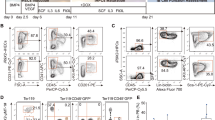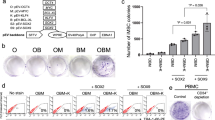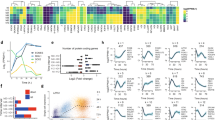Abstract
B cells have been shown to be refractory to reprogramming and B-cell-derived induced pluripotent stem cells (iPSC) have only been generated from murine B cells engineered to carry doxycycline-inducible Oct4, Sox2, Klf4 and Myc (OSKM) cassette in every tissue and from EBV/SV40LT-immortalized lymphoblastoid cell lines. Here, we show for the first time that freshly isolated non-cultured human cord blood (CB)- and peripheral blood (PB)-derived CD19+CD20+ B cells can be reprogrammed to iPSCs carrying complete VDJH immunoglobulin (Ig) gene monoclonal rearrangements using non-integrative tetracistronic, but not monocistronic, OSKM-expressing Sendai Virus. Co-expression of C/EBPα with OSKM facilitates iPSC generation from both CB- and PB-derived B cells. We also demonstrate that myeloid cells are much easier to reprogram than B and T lymphocytes. Differentiation potential back into the cell type of their origin of B-cell-, T-cell-, myeloid- and fibroblast-iPSCs is not skewed, suggesting that their differentiation does not seem influenced by ‘epigenetic memory’. Our data reflect the actual cell-autonomous reprogramming capacity of human primary B cells because biased reprogramming was avoided by using freshly isolated primary cells, not exposed to cytokine cocktails favoring proliferation, differentiation or survival. The ability to reprogram CB/PB-derived primary human B cells offers an unprecedented opportunity for studying developmental B lymphopoiesis and modeling B-cell malignancies.
This is a preview of subscription content, access via your institution
Access options
Subscribe to this journal
Receive 12 print issues and online access
$259.00 per year
only $21.58 per issue
Buy this article
- Purchase on Springer Link
- Instant access to full article PDF
Prices may be subject to local taxes which are calculated during checkout



Similar content being viewed by others
References
Wu SM, Hochedlinger K . Harnessing the potential of induced pluripotent stem cells for regenerative medicine. Nat Cell Biol 2011; 13: 497–505.
Aasen T, Raya A, Barrero MJ, Garreta E, Consiglio A, Gonzalez F et al. Efficient and rapid generation of induced pluripotent stem cells from human keratinocytes. Nat Biotechnol 2008; 26: 1276–1284.
Sun N, Panetta NJ, Gupta DM, Wilson KD, Lee A, Jia F et al. Feeder-free derivation of induced pluripotent stem cells from adult human adipose stem cells. Proc Natl Acad Sci USA 2009; 106: 15720–15725.
Merling RK, Sweeney CL, Choi U, De Ravin SS, Myers TG, Otaizo-Carrasquero F et al. Transgene-free iPSCs generated from small volume peripheral blood nonmobilized CD34+ cells. Blood 2013; 121: e98–107.
Meng X, Neises A, Su RJ, Payne KJ, Ritter L, Gridley DS et al. Efficient reprogramming of human cord blood CD34+ cells into induced pluripotent stem cells with OCT4 and SOX2 alone. Mol Ther 2012; 20: 408–416.
Ramos-Mejia V, Montes R, Bueno C, Ayllon V, Real PJ, Rodriguez R et al. Residual expression of the reprogramming factors prevents differentiation of iPSC generated from human fibroblasts and cord blood CD34+ progenitors. PLoS One 2012; 7: e35824.
Loh YH, Agarwal S, Park IH, Urbach A, Huo H, Heffner GC et al. Generation of induced pluripotent stem cells from human blood. Blood 2009; 113: 5476–5479.
Okita K, Yamakawa T, Matsumura Y, Sato Y, Amano N, Watanabe A et al. An efficient nonviral method to generate integration-free human-induced pluripotent stem cells from cord blood and peripheral blood cells. Stem Cells 2013; 31: 458–466.
Seki T, Yuasa S, Oda M, Egashira T, Yae K, Kusumoto D et al. Generation of induced pluripotent stem cells from human terminally differentiated circulating T cells. Cell Stem Cell 2010; 7: 11–14.
Staerk J, Dawlaty MM, Gao Q, Maetzel D, Hanna J, Sommer CA et al. Reprogramming of human peripheral blood cells to induced pluripotent stem cells. Cell Stem Cell 2010; 7: 20–24.
Barrett R, Ornelas L, Yeager N, Mandefro B, Sahabian A, Lenaeus L et al. Reliable generation of induced pluripotent stem cells from human lymphoblastoid cell lines. Stem Cells Transl Med 2014; 3: 1429–1434.
Hanna J, Markoulaki S, Schorderet P, Carey BW, Beard C, Wernig M et al. Direct reprogramming of terminally differentiated mature B lymphocytes to pluripotency. Cell 2008; 133: 250–264.
Choi SM, Liu H, Chaudhari P, Kim Y, Cheng L, Feng J et al. Reprogramming of EBV-immortalized B-lymphocyte cell lines into induced pluripotent stem cells. Blood 2011; 118: 1801–1805.
Di Stefano B, Sardina JL, van Oevelen C, Collombet S, Kallin EM, Vicent GP et al. C/EBPalpha poises B cells for rapid reprogramming into induced pluripotent stem cells. Nature 2014; 506: 235–239.
Nishimura K, Sano M, Ohtaka M, Furuta B, Umemura Y, Nakajima Y et al. Development of defective and persistent Sendai virus vector: a unique gene delivery/expression system ideal for cell reprogramming. J Biol Chem 2011; 286: 4760–4771.
Okano S, Yonemitsu Y, Nagata S, Sata S, Onimaru M, Nakagawa K et al. Recombinant Sendai virus vectors for activated T lymphocytes. Gene Ther 2003; 10: 1381–1391.
Bueno C, Montes R, Melen GJ, Ramos-Mejia V, Real PJ, Ayllon V et al. A human ESC model for MLL-AF4 leukemic fusion gene reveals an impaired early hematopoietic-endothelial specification. Cell Res 2012; 22: 986–1002.
Nishimura T, Kaneko S, Kawana-Tachikawa A, Tajima Y, Goto H, Zhu D et al. Generation of rejuvenated antigen-specific T cells by reprogramming to pluripotency and redifferentiation. Cell Stem Cell 2013; 12: 114–126.
Ramos-Mejia V, Fernandez AF, Ayllon V, Real PJ, Bueno C, Anderson P et al. Maintenance of human embryonic stem cells in mesenchymal stem cell-conditioned media augments hematopoietic specification. Stem Cells Dev 2012; 21: 1549–1558.
Sanchez L, Gutierrez-Aranda I, Ligero G, Martin M, Ayllon V, Real PJ et al. Maintenance of human embryonic stem cells in media conditioned by human mesenchymal stem cells obviates the requirement of exogenous basic fibroblast growth factor supplementation. Tissue Eng Part C Methods 2012; 18: 387–396.
Ramos-Mejia V, Munoz-Lopez M, Garcia-Perez JL, Menendez P . iPSC lines that do not silence the expression of the ectopic reprogramming factors may display enhanced propensity to genomic instability. Cell Res 2010; 20: 1092–1095.
Castaño J, Menendez P, Bruzos-Cidon C, Straccia M, Sousa A, Zabaleta L et al. Fast and efficient neural conversion of human hematopoietic cells. Stem Cell Reports 2014; 3: 1118–1131.
Giorgetti A, Montserrat N, Aasen T, Gonzalez F, Rodriguez-Piza I, Vassena R et al. Generation of induced pluripotent stem cells from human cord blood using OCT4 and SOX2. Cell Stem Cell 2009; 5: 353–357.
Catalina P, Montes R, Ligero G, Sanchez L, de la Cueva T, Bueno C et al. Human ESCs predisposition to karyotypic instability: Is a matter of culture adaptation or differential vulnerability among hESC lines due to inherent properties? Mol Cancer 2008; 7: 76.
Gutierrez-Aranda I, Ramos-Mejia V, Bueno C, Munoz-Lopez M, Real PJ, Macia A et al. Human induced pluripotent stem cells develop teratoma more efficiently and faster than human embryonic stem cells regardless the site of injection. Stem Cells 2010; 28: 1568–1570.
Calvanese V, Horrillo A, Hmadcha A, Suarez-Alvarez B, Fernandez AF, Lara E et al. Cancer genes hypermethylated in human embryonic stem cells. PLoS One 2008; 3: e3294.
van Dongen JJ, Langerak AW, Bruggemann M, Evans PA, Hummel M, Lavender FL et al. Design and standardization of PCR primers and protocols for detection of clonal immunoglobulin and T-cell receptor gene recombinations in suspect lymphoproliferations: report of the BIOMED-2 Concerted Action BMH4-CT98-3936. Leukemia 2003; 17: 2257–2317.
Gonzalez D, Gonzalez M, Balanzategui A, Sarasquete ME, Lopez-Perez R, Chillon MC et al. Molecular characteristics and gene segment usage in IGH gene rearrangements in multiple myeloma. Haematologica 2005; 90: 906–913.
Lopez-Perez R, Garcia-Sanz R, Gonzalez D, Balanzategui A, Chillon MC, Alaejos I et al. Gene scanning of VDJH-amplified segments is a clinically relevant technique to detect contaminating tumor cells in the apheresis products of multiple myeloma patients undergoing autologous peripheral blood stem cell transplantation. Bone Marrow Transplant 2001; 28: 665–672.
Ayllon V, Bueno C, Ramos-Mejia V, Navarro-Montero O, Prieto C, Real PJ et al. The Notch ligand DLL4 specifically marks human hematoendothelial progenitors and regulates their hematopoietic fate. Leukemia 2015; 29: 1741–1753.
Ramos-Mejia V, Melen GJ, Sanchez L, Gutierrez-Aranda I, Ligero G, Cortes JL et al. Nodal/Activin signaling predicts human pluripotent stem cell lines prone to differentiate toward the hematopoietic lineage. Mol Ther 2010; 18: 2173–2181.
Ramos-Mejia V, Navarro-Montero O, Ayllon V, Bueno C, Romero T, Real PJ et al. HOXA9 promotes hematopoietic commitment of human embryonic stem cells. Blood 2014; 124: 3065–3075.
Real PJ, Ligero G, Ayllon V, Ramos-Mejia V, Bueno C, Gutierrez-Aranda I et al. SCL/TAL1 regulates hematopoietic specification from human embryonic stem cells. Mol Ther 2012; 20: 1443–1453.
Real PJ, Navarro-Montero O, Ramos-Mejia V, Ayllon V, Bueno C, Menendez P . The role of RUNX1 isoforms in hematopoietic commitment of human pluripotent stem cells. Blood 2013; 121: 5250–5252.
French A, Yang CT, Taylor S, Watt SM, Carpenter L . Human induced pluripotent stem cell-derived B lymphocytes express sIgM and can be generated via a hemogenic endothelium intermediate. Stem Cells Dev 2015; 24: 1082–1095.
Vodyanik MA, Bork JA, Thomson JA, Slukvin II . Human embryonic stem cell-derived CD34+ cells: efficient production in the coculture with OP9 stromal cells and analysis of lymphohematopoietic potential. Blood 2005; 105: 617–626.
Davis MM, Bjorkman PJ . T-cell antigen receptor genes and T-cell recognition. Nature 1988; 334: 395–402.
Kisielow P, von Boehmer H . Development and selection of T cells: facts and puzzles. Adv Immunol 1995; 58: 87–209.
Mali P, Chou BK, Yen J, Ye Z, Zou J, Dowey S et al. Butyrate greatly enhances derivation of human induced pluripotent stem cells by promoting epigenetic remodeling and the expression of pluripotency-associated genes. Stem Cells 2010; 28: 713–720.
Sullivan GJ, Bai Y, Fletcher J, Wilmut I . Induced pluripotent stem cells: epigenetic memories and practical implications. Mol Hum Reprod 2010; 16: 880–885.
Chou BK, Mali P, Huang X, Ye Z, Dowey SN, Resar LM et al. Efficient human iPS cell derivation by a non-integrating plasmid from blood cells with unique epigenetic and gene expression signatures. Cell Res 2011; 21: 518–529.
Srinivasan L, Sasaki Y, Calado DP, Zhang B, Paik JH, DePinho RA et al. PI3 kinase signals BCR-dependent mature B cell survival. Cell 2009; 139: 573–586.
Di Tullio A, Vu Manh TP, Schubert A, Castellano G, Mansson R, Graf T . CCAAT/enhancer binding protein alpha (C/EBP(alpha))-induced transdifferentiation of pre-B cells into macrophages involves no overt retrodifferentiation. Proc Natl Acad Sci USA 2011; 108: 17016–17021.
Kim K, Zhao R, Doi A, Ng K, Unternaehrer J, Cahan P et al. Donor cell type can influence the epigenome and differentiation potential of human induced pluripotent stem cells. Nat Biotechnol 2011; 29: 1117–1119.
Acknowledgements
This work was supported by the European Research Council to P.M (ERC-2014-CoG-646903), the ISCIII/FEDER (E-Rare-2 Call PI12/03112 to PM, CP11/00131 to AFF and PI14/01191 to CB), MINECO (SAF2013-43065 to PM and SAF2012-37167 to TG), The Foundation TV3 Marato (120410 to TG), The Spanish Association Against Cancer to PM and MCC, and The Generalitat de Catalunya (SGR330 to PM and SGR1136 to TG). CB is supported by a Miguel Servet II contract (CPII13/00011). DRM and AM-L are supported by PFIS (FI11/0511) and FPI (BES-2014-067844) scholarships, respectively. PM also acknowledges the financial support from The Obra Social La Caixa-Fundaciò Josep Carreras. TG acknowledges the support by the Technology and Business Development Office of CRG within the framework of its proof-of-concept programs. CB, PM, JCS and OQ-B are investigators of the Spanish Cell Therapy cooperative network (TERCEL). Special thanks to Dr Lee Carpenter (University of Oxford, UK) and Dr Igor Slukvin (University of Wisconsin, MA) for providing MS5 and OP9 cells, and Dra. Dolors Comoler (IDIBAPS, Barcelona) for valuable help with the VDJH assays.
Author contributions
CB, JLS: conceived the study, designed and performed experiments, analyzed data and wrote the manuscript. KN, MO, MN: contributed key reagents and interpreted the data. BDS, DR-M, AM-L, MCC, AB, LA, JC, AH, OQ-B, JCS, MFF, AF, IG: performed experiments. TG: conceived the study. PM: conceived the study, designed experiments, analyzed data and wrote the manuscript.
Author information
Authors and Affiliations
Corresponding authors
Ethics declarations
Competing interests
The authors declare no conflict of interest.
Additional information
Supplementary Information accompanies this paper on the Leukemia website
Rights and permissions
About this article
Cite this article
Bueno, C., Sardina, J., Di Stefano, B. et al. Reprogramming human B cells into induced pluripotent stem cells and its enhancement by C/EBPα. Leukemia 30, 674–682 (2016). https://doi.org/10.1038/leu.2015.294
Received:
Revised:
Accepted:
Published:
Issue Date:
DOI: https://doi.org/10.1038/leu.2015.294
This article is cited by
-
Generating hematopoietic cells from human pluripotent stem cells: approaches, progress and challenges
Cell Regeneration (2023)
-
A Concise Review on Induced Pluripotent Stem Cell-Derived Cardiomyocytes for Personalized Regenerative Medicine
Stem Cell Reviews and Reports (2021)
-
Human iPSC banking: barriers and opportunities
Journal of Biomedical Science (2019)
-
Robust and highly efficient hiPSC generation from patient non-mobilized peripheral blood-derived CD34+ cells using the auto-erasable Sendai virus vector
Stem Cell Research & Therapy (2019)
-
Establishment of induced pluripotent stem cells from normal B cells and inducing AID expression in their differentiation into hematopoietic progenitor cells
Scientific Reports (2017)



